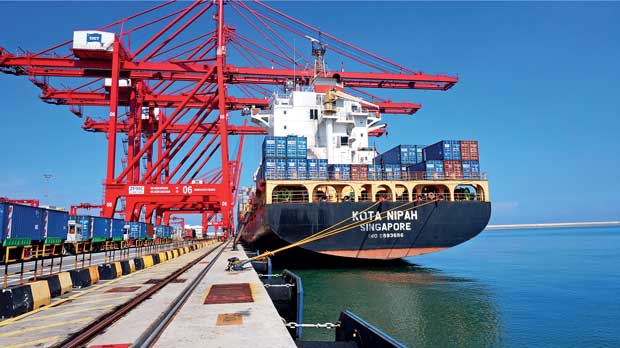03 Oct 2017 - {{hitsCtrl.values.hits}}

BY Dr. C.S. Weeraratna
According to a news item in Mirror Business of Daily Mirror on September 15, Development Strategies and International Trade Minister Malik Samarawickrama has emphasized the need to increase our exports. At the recently held symposium on Sri Lanka’s National Export Strategy (NES), the same minister and his deputy too indicated the need to increase our exports. The prime minister, at several meeting highlighted the importance of increasing exports. Our trade deficit has continued to increase during the last few years to almost Rs.1400 billion in 2016. The contribution of exports as a percentage of gross domestic product (GDP) has decreased from 33 percent in 2000 to 12.7 percent in 2016. Hence, it is obvious that our exports have to be increased.
Newspaper reports indicate that the quantity of most of our exports has dwindled during the last few years. Production of tea, our main export product, has continued to decrease from 340 million kilogrammes in 2013 to 292 million kilogrammes in 2016. However, the global tea production has increased bringing the Sri Lanka share in world tea production to 6 percent from 10.5 percent in the year 2000. Rubber production too has decreased from 152 million kilogrammes in 2012 to 79 kilogrammes in 2016. Exports of other crops do not show any substantial increase during the last few years.
In fact, production of some of these crops has decreased. Earnings from industrial exports, which account for around three-fourths of total export earnings too has contracted by 1.0 percent. According to the 2016 Central Bank annual report, our trade deficit has continued to increase from Rs.1,196 billion in 2012 to Rs.1,325 billion in 2016. All these data indicate that our exports are dwindling and it is sine qua nun that an effective plan is implemented to increase our exports.
With the European Union’s (EU) Foreign Affairs Council deciding to grant additional trade preferences to Sri Lanka under its GSP Plus initiative, around 1200 Sri Lankan products would be benefited. In 2016, Sri Lanka exported Rs.3.1 billion worth exports to the EU. It is important that the relevant programmes are implemented early to promote the production of those products which have a potential for exports.
Around two million hectares of the country remain uncultivated/partly cultivated. Sri Lanka has a wide variation in soil and climate with 46 agro-ecological zones, each characterized by specific climate and soils making it possible the cultivation of a number of different types of crops such as tuberous crops, horticultural and floricultural crops, medicinal herbs, cane, bamboo, sunflower, castor, etc., which have a considerable export potential.
Although there are many organisations such as the Industry and Commerce Ministry, Export Development Board, Industrial Development Board, etc. there appears to be no proper long-term plan to develop agro-industries, except for some ad hoc projects. The Industry and Agriculture Ministry should implement an effective agro-industrial development programme, which undoubtedly would increase our exports, improve employment opportunities and incomes in the rural areas. Products of small and medium enterprises (SMEs) have a high export potential and play a very important role in Sri Lanka’s economic development because they have the capacity to achieve rapid economic growth, while generating a considerable extent of employment opportunities. Promotion of SMEs would result in increasing the industrial output of the country leading to more exports.
However, not much emphasis appears to have been placed on improving SMEs except providing loans by banks. A main factor that limits the SME sector is inadequate raw materials. For example, cane is not available for those in this sub-sector. It is so in the other sub-sectors too.
Reducing imports
While we take action to increase our exports it is essential that expenditure on imports is reduced. Among the food items imported in 2015 are sugar (Rs.34 billion) milk (Rs.34 billion), lentils (Rs.20 billion) onion (Rs.16 billion), maize (Rs.10 billion), herbs such as katuwelbatu, thippili used for ayurvedic drugs, etc. Most of these can be locally produced and expenditure on imports of these items can be thus reduced. For example, sugar production in the country has not increased by any appreciable amounts during the present decade. The Kanthale sugar factory remains closed while a plan to cultivate sugarcane in Bibile remains shelved.
With regard to milk production, we have around one million cattle consisting of mostly indigenous cattle.
Their productivity is low (one to three litres/day) mainly due to the poor nature of the breeds and inadequate low-quality feed supply.
The dairy industry has a potential to contribute considerably to Sri Lanka’s economic development. Milk production also plays an important role in alleviating nutritional poverty and it is a source of extensive employment opportunities. If milk production can be increased, an appreciable amount of foreign exchange spent on milk imports can be reduced and improve the nutrition status of the people.
Although we say that we are self-sufficient in rice (a carbohydrate) a large amounts of wheat flour (another carbohydrate) is imported at a cost of around Rs.45 billion.
The annual wheat consumption in the country has increased from 38 kg/per person to nearly 80 kg/per person. There are many tuberous crops such as ‘innala’, sweet potato, yams, which can replace a part of the wheat flour we import.
There has been rhetoric on promoting exports. It is meaningful and effective actions that are necessary. Giving talks at numerous seminars, etc. will not increase exports unless there is a realistic plan implemented effectively.
(Dr. C.S. Weeraratna was a Professor of Agronomy at Ruhuna University and Professor of Soils and Water Resources at Rajarata University. He can be contacted at [email protected])
25 Nov 2024 9 minute ago
25 Nov 2024 1 hours ago
25 Nov 2024 1 hours ago
25 Nov 2024 3 hours ago
25 Nov 2024 4 hours ago